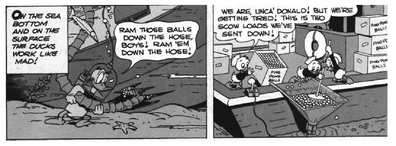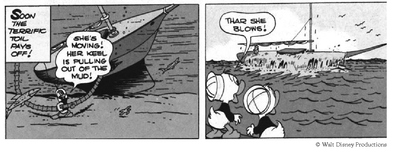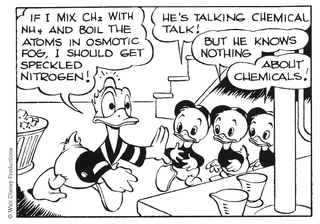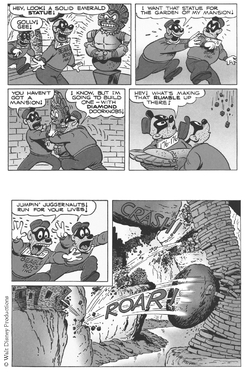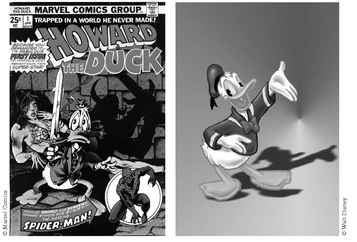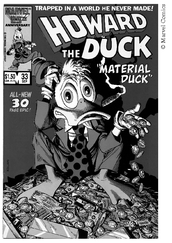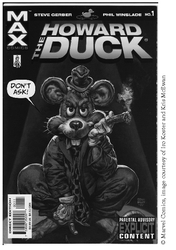10
WALT DISNEY COMICS
Walt Disney comics first began appearing in newspaper comic strips in 1930 with a Mickey Mouse strip. In 1932 Mickey Mouse gained a partner when the strip was joined by the Silly Symphonies strip, which starred various Disney characters. In 1934 Donald Duck first appeared in the Silly Symphonies strip and soon took over the strip entirely. The Mickey Mouse strips were drawn by acclaimed comic artist Floyd Gottfredson for over forty years, while the Donald Duck strips were drawn by Al Taliaferro.
In 1940 Western Publishing purchased the rights to the Disney strips and began reprinting them, through a partnership with Dell Comics, in the pages of Four Color Comics. The reprint books were so popular that in 1940 they soon decided to start a brand-new title featuring original made-for-comic-books content, Walt Disney’s Comics and Stories. It was in this series that Carl Barks began his legendary run on the Disney titles. Walt Disney’s Comics and Stories became one of the most popular comics series of the 1950s, selling in the millions per month. In 1961 Western formed its own comic book company, Gold Key, which took over the Disney titles.
In 1947 Barks introduced a new character in a Christmas story in Walt Disney’s Comics and Stories #178, “Christmas on Bear Mountain.” The character, Scrooge McDuck, was a takeoff of Ebenezer Scrooge from the Charles Dickens Christmas classic A Christmas Carol. He was a hit with readers, and after a few more guest appearances in Donald Duck stories, Scrooge received his own title, Uncle Scrooge, in 1952. Along with Walt Disney Comics and Stories, they are the only Disney comic books that are still published in the United States.
While Disney comics are surprisingly not that popular in the United States, where it is difficult keeping even two Disney titles afloat, they are massively successful in the rest of the world, especially Europe. While sales in Europe have cooled off a bit in recent years, they still sell quite well in most countries—higher than the most successful comics in the United States (and considering the population differences between the United States and countries like, say, Denmark, it is quite impressive how well the books sell).
The most notable Disney comic book artist is the aforementioned Carl Barks, who was so popular among readers of the comics that he was given a name by fans back when Disney did not list credits in its comics. He was known worldwide as the Good Duck Artist and the Duck Man because his Donald Duck (and later, his Uncle Scrooge) stories were considered to be a step ahead of the rest, even the great artists like Tony Strobl and Paul Murry.
Nowadays, William Van Horn and Don Rosa are the two biggest names in Disney comics, although neither of them work for U.S. comic companies. They both work for European companies, but they work from the United States. Rosa is a devoted fan of Barks, and much of Rosa’s work is a sort of tribute to Barks’s comics. Rosa’s work has developed a strong critical following, and he has gotten a great deal of award recognition for his Uncle Scrooge comics.
OF THE MANY things that change in a culture over the years, sense of humor is right up there with acceptable lengths of women’s skirts and men’s hair. Some jokes that were commonplace in 1932 are avoided now because they are racist, sexist, and/or xenophobic, which is certainly a change for the better. However, there are other jokes that were acceptable then and would be shocking now that are more a matter of being daring with characters that the audience is used to seeing portrayed as fairly bland. It is striking to note that while Disney would most likely never dream of doing anything edgy with Mickey Mouse in 2008, Walt Disney himself was willing to do so almost eighty years ago.
When the Mickey Mouse comic strip began in 1930, Disney wrote the strip along with penciling by Ub Iwerks (cocreator of Mickey Mouse) and inking by Win Smith. Iwerks left the strip soon after it began, and Smith took on both penciling and inking. Soon Disney became so busy with running his company that he did not have the time to write the comic, at which point Smith balked at the prospect of going from simply being the inker of the strip to being the inker, penciller, and writer—so he quit. Disney then went to a recent hire at the company, Floyd Gottfredson, to take over. Gottfredson had been hired as an animator and was told that the newspaper strip assignment would just be temporary—until they could find a permanent replacement for Smith. The “temporary” assignment lasted from 1930 until 1975, when Gottfredson retired.
Gottfredson’s first story line was a continuation of an adventure Disney and Smith began, but in the fall of 1930 he was on his own. However, Disney managed to free up enough time to suggest a plot for Gottfredson, which he used in October of 1930, and it was a strange one.
Disney’s idea was that Mickey would see his girlfriend, Minnie Mouse, with another guy, then Mickey would go home and kill himself! The joke being that every time Mickey tried to commit suicide, something would happen that would foul up the attempt. Like right before he shoots himself in the head with a shotgun, a cuckoo clock rings out, making Mickey realize it would be cuckoo to shoot himself in the face. In the next strip, he jumps off a bridge, but lands on a boat below! The captain thinks he is a stowaway, but Mickey pleads with him not to throw him overboard because he can’t swim and would drown! In another strip, Mickey puts on the natural gas in his bedroom while he sleeps, hoping to suffocate to death, but a pesky squirrel breaks in to siphon the gas off to use to fill balloons.
This kept up for a while, until Mickey, while hanging rope on a tree to use as a noose, sees some squirrels laughing at him and realizes how silly all this has been. He decides not to kill himself and instead builds a swing out of the rope. Gottfredson thought it was bizarre when Disney asked him to do the plotline, but apparently Disney had seen it used in a 1920 film starring the comedic actor Harold Lloyd (along with Charlie Chaplin and Buster Keaton, the most popular comedy stars of the silent-film era). Since Lloyd and Mickey shared a lot of the same qualities (both are basic “everyman” characters), Disney felt it would work, and the strips appeared without any complaints from any newspapers.
One can only imagine what Disney thinks of the strips now. They were created by the founder of Disney and published in hundreds of newspapers across the nation almost eighty years ago, but I bet they would be considered far too risqué for Disney today—which is an interesting dichotomy, no?
CARL BARKS, NOTED earlier as the most famous Walt Disney comic artist of all time, very nearly did not become a comic book artist at all.
Barks was raised in Oregon, on a wheat ranch, from which he and his family would move to and from, following his father’s attempts at different ventures, all of which would fail. All the time they were traveling, Barks was practicing drawing, and when he was old enough to leave home, he did so, working various odd jobs while submitting cartoons at night. He would even draw cartoons for some of the racier men’s magazines before finally traveling to Minnesota in 1931 to take up a steady job drawing cartoons for the Calgary Eye-Opener. He ultimately became the editor of the magazine but left in 1935 to go work for Walt Disney’s animation studios.
Barks would work for the studios for seven long years, during which time he churned out about thirty-six Donald Duck shorts. In the early 1940s, working on collaborations was slowly driving Barks mad, but he still might not have left the studios if it had not been for something as simple as air-conditioning.
The air-conditioning at the studios caused Barks’s sinuses to act up, and he might have stuck out the sinus problems if he loved his job, and he might have stuck out the job if he did not have the sinus problems, but the combination was too great, so Barks quit. He prepared himself to live a life as a chicken farmer (as he and his second wife opened up a chicken farm east of Los Angeles).
When he was settled in, he contacted Western Publishing to see if it was interested in him pitching a new series of comic characters. The company turned him down but did tell him it needed someone to do some Donald Duck comic book stories for Walt Disney’s Comics and Stories. Barks started working on the series and did not stop for the next twenty-five years—even past his retirement! After his retirement, Barks was so famous around the world (and so respected by Disney) that Disney gave him permission to produce oil-painting versions of famous scenes from his comics. Those paintings would soon each be worth a miniature fortune, with prints of the paintings selling for thousands of dollars. When he died in 2000, at the age of ninety-nine, Barks was mourned throughout the world.
Imagine if Disney Studios had simply fixed the air-conditioning?
KARL KRØYER WAS a prominent Danish inventor who established a firm of inventors and engineers that developed solutions to various problems. His most notable invention occurred during World War II. When food was being rationed, Krøyer developed new methods of food production, specifically sugar. He invented the continuous glucose process, which he patented as Total Sugar.
In 1964 the freighter Al-Kuwait sunk off the shores of Kuwait. Within the Al-Kuwait were several thousand sheep. Once drowned, the dead sheep would eventually contaminate the water, which was Kuwait’s primary source of drinking water. Therefore the ship needed to be raised as quickly as possible, and there was no floating crane available.
The ship was insured by a Dutch company, and it engaged Krøy-er’s firm to help. One of his young employees came up with the notion that entrapped air could possibly raise the boat. The employee demonstrated by using polystyrol (which is used in heat insulation). An airlift was sent from Berlin to Kuwait with twenty-seven million polystyrol pellets, weighing sixty-five tons. It raised the ship, saving the insurance company over a million dollars in insurance costs.
Krøyer then went on to successfully patent the process in England (GB 1070600) and Germany (DE1247893) but was denied a patent in the Netherlands. The Dutch patent office apparently turned him down because of nothing less than a Carl Barks comic!
When applying for a patent, you must prove that the patent is a “novel” idea—that no one else has come up with the same idea already. When someone has come up with something before you, it is referred to as “prior art.” So as long as it has been publicly described in the past, you cannot patent it, even if the prior idea was not patented.
In this incident, the prior art was a Carl Barks story in Walt Disney’s Comics and Stories #104, in 1949. In the story, Uncle Scrooge’s yacht has sunk, and Donald and nephews Huey, Dewey, and Louie raise the boat by filling the yacht with Ping-Pong balls through a tube. Essentially, it is the same process Krøyer used in 1964 (Barks’s Ping-Pong-ball process was tested out on a 2004 episode of the television program MythBusters—it worked!).
The story is often told that the idea came from the comic book, but all the parties involve deny that, and Krøyer was forty-five when the comic was released (although the younger employee may have been the right age to have read it).
The papers for the patent application were destroyed in a fire years ago, so it is difficult to prove that the comic is the specific reason why the patent was denied. However, recently the Netherlands Patent Office issued a statement confirming that it is, in fact, why the patent was denied.
Barks often made a point of trying to make the science in his comics as realistic as possible, so it is not that surprising that something he came up with actually worked.
CARL BARKS’S SCIENTIFIC genius did not only manifest itself in the world of engineering. In 1944, in Walt Disney’s Comics and Stories #44, Barks made Donald Duck the first duck (or man, see page 204) to discover the chemical compound methylene!
Methylene is a divalent hydrocarbon group that is derived from methane, specifically the carbene CH2. Carbenes are highly reactive organic molecules with a divalent carbon atom with only six valence electrons. Whether you understand any of the preceding or not, suffice it to say that chemists do understand it, and according to chemistry experts, Barks used methylene in a story in Walt Disney’s Comics and Stories #44.
In the tale, titled “The Mad Chemist,” Donald Duck is hit on the head, and the resulting injury makes him a genius when it comes to chemicals. He mixes together a group of various chemicals in jars to form Duckmite, the most ghastly explosive ever cooked up by man (note that Donald oddly refers to himself as “man”). At one point in the story, Donald references a number of chemicals, and one of the chemicals is CH2!
A technical article discussing methylene then appeared in a text called Carbene Chemistry, and the article cites the appearance of CH2 in the Barks story as being over a decade ahead of where chemists currently were in the discussion of methylene. The discussion of CH2 at all in a story in 1944 even predated the discovery of how to prove the existence of the chemical intermediate methylene.
Another chemist noted that while, yes, carbenes could not exist in the jars the way that Donald was mixing them in the comic story, they can be made to react with other substances, which real chemical scientists had not thought to try at the time of Barks’s strip.
So, without really trying, Barks was a step ahead of the entire field of chemistry! I suppose we are all lucky that Barks never turned his attention to how to make a nuclear reactor in your basement!
THE FACT THAT George Lucas and Steven Spielberg’s character Indiana Jones was at least partially inspired by Carl Barks’s classic Uncle Scrooge comics is fairly evident. Indiana Jones’s globe-trotting searches for lost artifacts are extremely similar to Uncle Scrooge’s trips (along with his nephew Donald and Donald’s nephews, Huey, Dewey, and Louie). This fact was made quite clear when George Lucas wrote the introduction to the collection of Carl Barks’s comics published in 1981, Walt Disney’s Uncle Scrooge McDuck: His Life and Times, and spoke directly about the influence the Barks stories had on both Spielberg and himself.
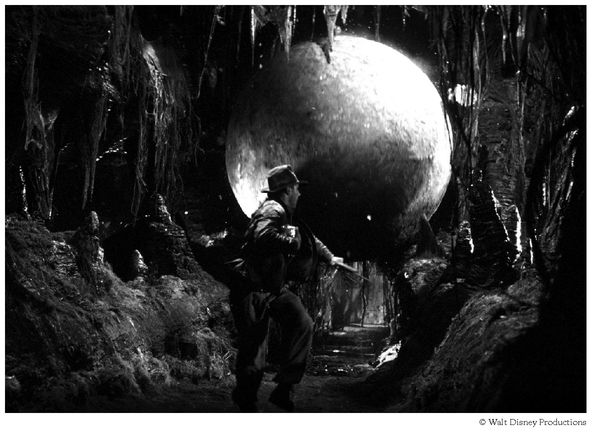
An oft-repeated but less clear-cut story is that Lucas and Spielberg’s famous rolling-boulder scene in Raiders of the Lost Ark was an homage to a Carl Barks’s comic story. The Barks scene in question appears in “The Seven Cities of Cibola,” from Uncle Scrooge #7, in which the Beagle Boys, just like Indiana Jones, remove an idol from a pedestal, tripping a lever that sets off a trap that releases a giant boulder down upon them.
That this is an homage is quite often passed off as an undisputed fact, but, really, while the scene certainly bears a resemblance to the famous rolling-boulder scene at the beginning of Raiders of the Lost Ark, it is not a straight reproduction by any measure. For instance, the boulders are vastly different sizes and fall in completely different manners. So it is surprising that histories of Barks have always referred to this as though the echo were explicit, but never with a cited source from Lucas or Spielberg.
Luckily, Edward Summer was able to give direct confirmation that the scene was, indeed, influenced by Barks’s work. Summer was a friend of Lucas, and it was Summer (along with Star Wars producer Gary Kurtz) who put together the aforementioned Barks collection and got Lucas to do the introduction. Each of the stories that appeared in the collection was remastered, including being re-colored. At one point in the production of the collection, Lucas and Summer were talking, and the specific comic that was being prepared for the book was “The Seven Cities of Cibola.” Lucas told the editor plainly that the boulder scene in Raider of the Lost Ark was a conscious homage to “The Seven Cities of Cibola.”
The editor of the collection, who is also a contemporary of Lucas, seems to be a reliable source of information. So yes, the rolling-boulder scene in Raiders of the Lost Ark is an homage to a Carl Barks Uncle Scrooge comic book. Summer, though, notes that the movie was filled with homages to a number of different sources, so while the boulder scene was a nod to Barks’s Uncle Scrooge, it could have also been nodding to any number of other works as well, all at the same time.
THE WALT DISNEY corporation has always been very aggressive in the protection of its trademarks, and that was the case when it got involved in the production of the Marvel comic book Howard the Duck, which it felt was too close in appearance to its Donald Duck character. Whatever Disney’s feelings the level of involvement Marvel allowed Disney is extremely surprising (not to mention disappointing).
Howard the Duck first appeared in a Man-Thing story as a throw-away gag, but creator Steve Gerber liked him enough to bring him back and soon gave him a backup story in Giant-Size Man-Thing #2 (one of the more sexually suggestive comic book names), and after Marvel saw a decent amount of popular support, Howard gained his own series in 1976 with Howard the Duck #1.
The comic is about a talking duck from another world, who is stuck on Earth and gets involved in a series of comical misadventures along with his girlfriend, model-actress Beverly Switzer. The series quickly became a cult hit and even spun off a newspaper strip for a year. Steve Gerber left the series in 1978 over a dispute regarding his rights as the creator of Howard. The series continued without Gerber, but as he was the driving force behind the book, it did not work that well, and after four issues, it relaunched as a black-and-white magazine. This, too, did not last long (only nine issues), and the character disappeared until George Lucas made a box-office flop starring the character.
After Gerber left the book, Disney contacted Marvel about the look of Howard. Disney felt that Howard too closely resembled Donald Duck, and it wanted Marvel to change his appearance.
Amazingly, Marvel agreed to a settlement in which a Disney artist did a redesign of Howard (one of the major points was that Howard had to wear pants) and Marvel had to agree to stick to that design.
This was an issue when Gerber finally returned to the character in 2002, for a story in Marvel’s “mature readers only” MAX line of comics. Gerber disliked the current look of Howard so asked the artist of the new series, Glenn Fabry, to attempt a redesign. It was then that he learned that, according to the deal, Marvel could not even attempt its own redesign. It was Disney’s design or nothing! Gerber was, expectedly, outraged and came up with an idea to get around the rules. Yes, they could not change Howard the Duck’s ducklike appearance, but there was nothing saying that they could not make him a different animal! So in each issue of the six-issue series, Gerber had Fabry draw Howard as a different animal. The very first animal was, in “honor” of Disney, a mouse.
Marvel must have managed to rework the agreement (or else decided to risk it), because in 2007 it released a new Howard the Duck miniseries with a brand-new design of Howard by the book’s artist, Juan Bobillo.
WITH THE AMOUNT of litigation Disney is routinely involved in over its trademark protection, it is remarkable to note that it has allowed the University of Oregon to use Donald Duck as its mascot for over sixty years!
The Oregon Ducks’ first school nickname was the Webfoots, a term referring to fishermen from the area during the nineteenth century. Eventually, Webfoots was shortened to, and then kept as, Ducks.
This was especially prominent during the 1920s and ’30s, when the school began bringing a live duck named Puddles to its games as the school mascot. This practice was objected to by the Humane Society and was finally canceled in the early 1940s. By that time, depictions of the duck had already begun to proliferate in school newspapers when discussing the football team, and the duck began to be drawn looking like Donald Duck. Eventually, the team logo was, essentially, Donald Duck. In the late 1940s, the Walt Disney Company began to notice—and disapproved.
Luckily, Oregon athletic director Leo Harris was close friends with an employee at Disney and managed to set up a meeting with Walt Disney himself. Harris flew to Los Angeles to ask Disney to allow the school to continue using Donald as its mascot. Disney agreed, and the two shook on the deal (without, though, formalizing the agreement through a written contract). At the time, Harris, Disney, and two other men posed for a photograph together, squatting behind Puddles.
Oregon continued to use Donald for the next couple of decades, until Disney passed away in 1966. At this point, Oregon was quite mindful of the fact that it did not actually have a written contract with Disney. When the company asked about the deal, all it had to prove it was, well, the photograph!
Ultimately, Disney decided that the photo was fairly good evidence of Walt’s intent regarding the school’s mascot, so it eventually signed a written contract allowing Oregon to maintain Donald as its mascot, with the caveat that it was only for school functions, and any merchandise bearing Donald could only be sold in Oregon, with the profits split between the university and Disney.
While such a deal made sense to Oregon at the time, by the turn of the twenty-first century, such an agreement was pretty limiting, as sales of college football merchandise was now a national enterprise. Around this same time, Oregon coincidentally introduced a new, additional duck mascot (designed by Nike, which has a very close relationship with the University of Oregon, as Nike cofounder and president Phil Knight is an alumnus, and the other cofounder was a track-and-field coach for Oregon), which it said was just an attempt to have a separate, more agile mascot to accompany Donald. That might be the case, or perhaps it was a hint to Disney that it would be prepared to replace Donald if the contract was not renegotiated.
In any case, a new agreement was eventually signed, but the terms were sealed, and since no new merchandise with Donald has popped up, it appears as though the terms did not change that much.
